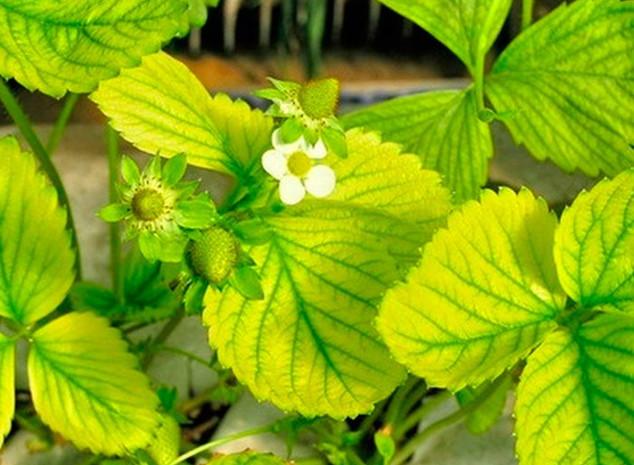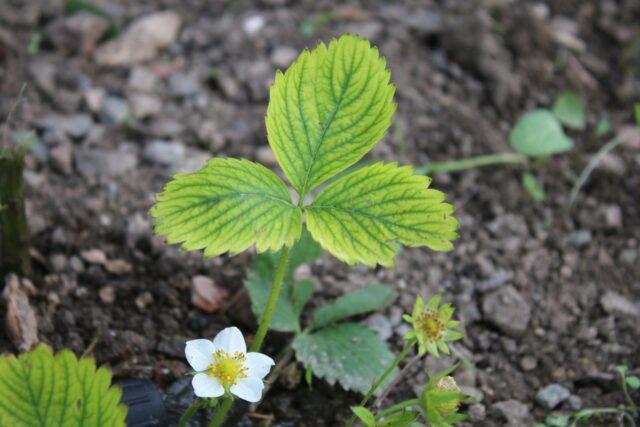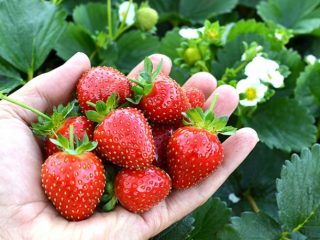Content
Gardeners who grow strawberries often encounter chlorosis - yellowing or lightening of leaves. The disease is not dangerous, but can deteriorate the quality of berries and reduce yield. For a fruitful fight, it is necessary to determine the causes and treatment of strawberry chlorosis depending on its type.

The cause of chlorosis may be a hereditary factor
What does chlorosis of strawberry leaves look like?
The main sign of chlorosis is a yellowish tint to the foliage. Upon careful examination of the plants, in addition to it, other symptoms of the disease are discovered:
- Gradual grinding of sheet plates.
- Curling their edges.
- Drying of the tops of the shoots.
- Falling of leaves and inflorescences.
- Rotting and further death of the root system.
With viral chlorosis, you can notice that the internodes of plants are shortened. The main reason for such changes is the cessation of chlorophyll formation as a result of a decrease in the process of photosynthesis.

Spraying treatment should be carried out in cloudy weather.
Types of chlorosis of strawberry leaves
Depending on the cause of the disease, chlorosis is divided into two types - infectious and non-infectious.The first is caused by viruses, microorganisms and fungi. Their carriers are pests living on the site. The reasons for the appearance of non-infectious chlorosis are violation of agricultural practices for growing strawberries, lack of nutrients and macroelements in the soil, difficult weather conditions, waterlogged soil, lack of drainage and mechanical damage to the roots.
Depending on which element the strawberry is deficient in, non-infectious chlorosis is divided into several groups:
- Ironwood is the most common type, the veins of young foliage remain green, and the space between them is yellow or white.
- Magnesium - often found in sandy soils, yellowing is first visible on the edges of older leaves and later spreads to the rest of them, the color may be red or orange.
- Sulfur - first affects the veins of young foliage, and then the rest turns yellow.
- Nitrogen - the disease is common in acidic soils; the veins on the lower leaf blades turn white, then the areas adjacent to them, and later the entire leaf.
- Zinc - occurs due to an excess of nitrogen, red, yellow, orange specks appear.
To decide on treatment, it is necessary to find the causes and make a diagnosis.
Causes of strawberry chlorosis
Lightening of leaves on strawberries can occur not only due to elementosis (lack of macroelements in the soil), but also for other reasons:
- Increased humidity due to frequent and prolonged rains, leading to a drop in the concentration of nutrients in the soil.
- Fluctuations and sharp drops in air and soil temperatures, as a result of which the roots reduce the absorption of nutrients and the growth of the bush slows down.
- Reduced photosynthesis due to poor lighting and shading of strawberries.
- An excess of nitrogen in the soil results in a deficiency of potassium and phosphorus.
- Increase in nitrogen content after applying large amounts of manure and compost.
- High acidity of the soil.

In addition to strawberries, raspberries, currants, apple trees and vegetable crops are susceptible to chlorosis.
What happens if the disease is not treated?
Chlorosis does not end with simple yellowing of the foliage. Without proper treatment, you can lose your plants. This happens after the course of the disease has started. Complete death of strawberries rarely occurs, but without treatment, the yield drops, the immunity of the berry bushes decreases, they often get sick and become extremely susceptible to pests.
Infectious chlorosis carried by insects is rare. His treatment is absolutely pointless. To prevent the infection from spreading to other plants, they should be dug up and burned. The soil is disinfected with Fitosporin, bleach or copper preparations.
How to treat strawberry chlorosis
To treat strawberry chlorosis, a disease of a non-infectious type, ready-made preparations are used or formulations are created independently. Having understood the cause of the pathology, they select fertilizing so as to compensate for the lack of the element missing in the soil.
Magnesium chlorosis is eliminated with dolomite flour, potassium magnesium, magnesium sulfate, using them according to the instructions. Among folk remedies, wood ash is used as a treatment.
The lack of sulfur is compensated for with fertilizers - azophoska and diammofoska. If the cause of chlorosis is a lack of nitrogen, ammonium sulfate or ammonium nitrate is useful, which must be handled carefully, avoiding overheating.
If fertilizers are used thoughtlessly, without following the rules of application and dosage, the plants begin to get sick from an excess of minerals.
When it is unknown which specific macronutrient deficiency caused chlorosis, complex mineral fertilizers are used for treatment:
- Bio Master.
- Mortar.
- Aquarin.
- Station wagon.
- Kemira Lux.
Treatment with chemicals when strawberry leaves are damaged by chlorosis can be replaced by a decoction of onion peels mixed with an infusion of wood ash and water left after washing cereals, rich in useful substances. The mixture can be watered and sprayed on strawberries. By monitoring how the plants react to fertilizing, it is determined whether the treatment was carried out correctly. Greening of young foliage is a sign that the cause has been found and the disease has subsided.

An alkaline environment in the soil often causes chlorosis
Treatment of strawberry chlorosis with iron sulfate
It is difficult to determine what type of chlorosis has affected strawberries without conducting special laboratory tests. Most often, the foliage turns yellow due to a lack of iron. They lighten evenly, and the veins remain bright green. Symptoms of strawberry chlorosis (photo) and treatment depend on the extent of the damage. First, the upper leaves turn white, and then the main ones. In order to get rid of the pathology, fertilizer (Ferovit) is applied under the roots and the foliage is sprayed with a solution of iron sulfate. There is a folk method for determining chlorosis. A cotton swab is dipped in the prepared liquid and any sign is drawn on a yellow sheet. If the assumption of iron deficiency is correct, the inscription will turn bright green.

The disease begins at the tops of the foliage
Having decided on the diagnosis and cause, treatment begins:
- Use acidified water for irrigation.
- Add iron to the strawberry diet by spraying the foliage with it.
The macroelement must be in chelated form - quickly absorbed by above-ground and underground parts of berry bushes. It is easy to create at home from iron sulfate:
- Dissolve ½ tsp in 1 liter of boiled water. citric acid.
- Add 2.5 g of iron sulfate to the solution.
- It is used for watering and spraying foliage.
There is another way to make iron chelate for treatment:
- Iron sulfate (10 g) is diluted in 1 liter of water.
- Ascorbic acid (20 g) is added to the solution.
- Plants with chlorosis are sprayed with it.

The cause of falling flowers, buds and ovaries can be calcium chlorosis
Prevention
To prevent yellowing of strawberry foliage on the site, take preventive measures in advance and monitor the condition and health of the plants.
Infectious chlorosis most often affects them at the time of planting. To avoid disease, the soil is disinfected by treating it with biofungicides. The procedure can be replaced by sowing green manure, which cleans the soil of pathogenic fungi and pests and improves its structure without the use of chemicals. When working in the garden, the tool must be kept clean, and after use on diseased plants, it must be disinfected. To prevent affected foliage and plants from causing chlorosis, they are removed from the site and burned. Strawberry planting material is treated with a solution of potassium permanganate.
Non-infectious chlorosis does not pose a great threat; its treatment and prevention is not difficult.If it is known which specific element the plant lacks, its deficiency is compensated. In the absence of such information, complex mineral fertilizers containing macro- and microelements are regularly applied to the strawberries (according to the instructions). A prerequisite for the prevention of chlorosis is keeping the site clean, timely removal of weeds, loosening and creating high-quality soil drainage.
It is very important not only to choose the right site for strawberries, but also to pay attention to the predecessors of the crop. You should not plant plants after nightshades or asteraceae, but cereals, garlic, and parsley will help protect berry bushes from disease and further treatment.
Varieties resistant to disease
Breeders are constantly working to create varieties that are resistant to diseases and at the same time have excellent characteristics - taste, winter hardiness, drought resistance. There is no ideal garden strawberry, but varieties that are weakly susceptible to chlorosis include:
- Relay race (Nullam).
- Vima Kimberly.
- Queen (Regina).
- Fireworks (Pompa).
- Clery.
- Consul.
- Early Crimea.
- Honey.
Conclusion
If a diagnosis has been made, the causes and treatment of strawberry chlorosis are known, it should be carried out immediately; you should not delay this process. Sometimes one fertilizing is enough to correct the situation and avoid a decrease in yield and quality of berries. In order to prevent the disease in the future, it is worth paying attention to the condition of the plants, the color of the foliage, the rate of growth and development of the strawberries.
















